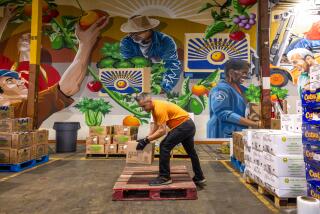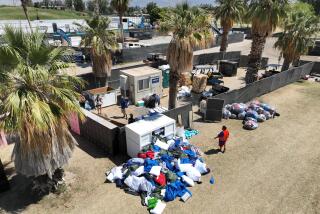Needy Don’t Get Most Thrift Shop Revenue in O.C.
- Share via
The sale of American-donated used clothing generates hundreds of millions of dollars in revenue for private dealers as well as large nonprofits.
So what’s actually left for charity?
In fact, little trickles down to the beneficiaries.
Goodwill Industries of Orange County, for example, reported $8.8 million in thrift store revenue in 1995. Finance director Arthur Mattson said there was a $1.3-million profit, but he did not know how much of that actually went to programs.
“It’s all just thrown in the big pot for whatever bills there are,” he said. “We would like it to be more. If we lost money at this, we would dump it tomorrow.”
The top eight managers at Goodwill of OC earned $600,000 that year, with wages and added benefits ranging from $187,000 for the executive director to $73,000 for the program director.
The same year, 380 disabled “trainee” clients were paid $545,000, or as little as 50 cents an hour, for working at Goodwill assembly line jobs. The organization also helped 208 disabled people find mainstream jobs in 1995, mostly in fast-food operations and janitorial service.
Children’s Hospital of Orange County generated $9.9 million in sales in 1995 from used clothing, making it the most successful charity in the county. But CHOC’s Thrift Stores Inc. was able to give only $625,000, or 6% of its gross revenue, to help pay the hospital bills of children whose families could not afford to pay.
“That is a low rate of return,” said Bernie Rothermell, CHOC’s chief financial officer. “In other years, we have had a higher rate, otherwise we would not continue to operate the stores.”
The Salvation Army, which is considered a church, does not have to reveal its finances in the same way as Goodwill or CHOC, which enjoy nonprofit status and must file annual reports with the IRS. But in interviews, Majors Daniel Starrett and Oliver Stenvick disclosed figures showing the Salvation Army apparently had the highest rate of return. Of the $9 million in thrift store sales and salvage revenue, 18% to 20% was plowed directly into the army’s 140-bed drug and alcohol rehabilitation center.
The center served 581 men in 1996, providing 140,000 meals and 46,000 nights of lodging free to recovering alcoholics and drug addicts, as well as extensive counseling services. In exchange, the men worked 40 hours a week or more in the warehouse, sorting clothing or repairing household goods.
The majors and their wives, who are the equivalent of church ministers and who dedicate their lives to God, earn a combined $224 a week, plus housing and clothing allowances.
More to Read
Inside the business of entertainment
The Wide Shot brings you news, analysis and insights on everything from streaming wars to production — and what it all means for the future.
You may occasionally receive promotional content from the Los Angeles Times.










